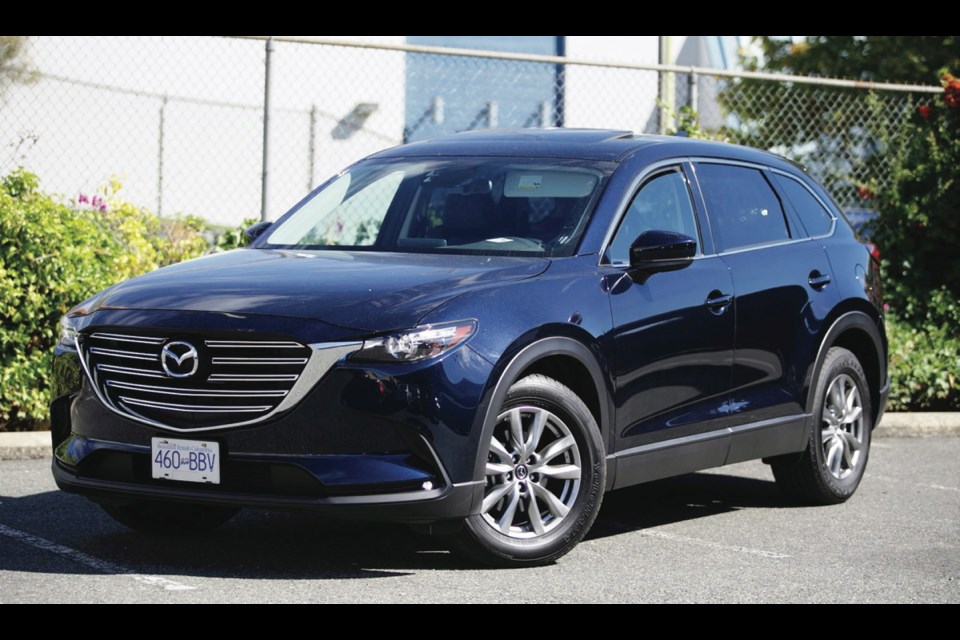The 2016 Mazda CX-9 puts the “sport” back in the SUV. It might be a midsized seven-passenger crossover, but deep in its heart there is a Miata sports car longing to get out and play.
Minivans are passé. Seven-passenger SUVs and crossovers are the new go-to vehicle for parents who require an extra two seats for the occasional need to accommodate friends of their children.
When not in use for passengers, the extra cargo capacity is valued for effortlessly carrying everything (including the kitchen sink) for trips to Home Depot or luggage for a cross-country trip to visit friends and family.
This new breed of sport-ute isn’t going anywhere off the road but, for most people in Canada, needs the ability to get them home in all sorts of weather.
The CX-9 hits all the right buttons for both aging enthusiasts who would love a Miata (but can’t get in one any more) and the young parents who need something that drives like a sports car, but doesn’t look or act like one.
The CX-9 comes in four trim levels, starting with a front-wheel-drive GS at $37,800. I drove the next model up, a GS-L, with a list price of $41,500.
It goes up against a impressive roster of competitors all after the same customer, including the Honda Pilot, Toyota Highlander, Hyundai Santa Fe XL, Ford Flex and Buick Enclave, just to name a few.
Faced with stiff competition, Mazda’s first move was a predictable one: It undercut the competition in price, by thousands compared with the Pilot but just hundreds against the Highlander. Of course, a direct comparison will vary due to different standard equipment among manufacturers.
The next move is somewhat unexpected, but may be the start of a trend. In a field dominated by V-6 engines, Mazda has introduced a turbocharged four instead.
Gone is last year’s 3.7-litre V-6. In its place is a turbocharged direct-injection 2.5-litre four-cylinder engine instead. While peak horsepower is down, torque is way up to 310 foot-pounds at a low 2,000 rpm.
The engine is mated to a six-speed automatic and all-wheel drive.
Ditching the larger and heavier engine — and an increased use of high-tensile steel in the body — means the new CX-9 is about 145 kilograms lighter than the model it replaces.
Combine the improved torque and a lighter body, and drivers will notice the first tangible result — a much peppier vehicle. I will go out on a limb to say the CX-9 is perhaps the sportiest seven-passenger SUV/crossover I have ever driven, save offerings by luxury/premium brands.
Mazda’s secret to a peppy vehicle is its torque, available at 2,000 rpm, which is just above idle. This means it’s right where most people want to feel power — pulling away from a stop. This translates into power delivery that is both linear and smooth all the way up to highway speeds.
The increased oomph and downsized mass yields another benefit: handling that is on par with sport sedans on the twisties. The suspension, like all Mazdas, is supple, yet firm. The GS-L is shod with 18-inch rubber, but the more premium trim levels get 20-inch tires.
Part of the recipe for fun is the sport mode on the six-speed transmission. Engage the system and the CX-9 seems to think it’s just a grown-up MX-5 Miata, with quick up and down gear changes. Although there is a manual mode on the gear lever, the CX-9 is sadly missing paddle shifters. Like all past Mazdas, you have to pull back on the stick to shift up, contrary to the majority of manufacturers.
I wouldn’t carve canyons with children in the back, but you can drive with abandon without embarrassing yourself on back roads. If circumstances dictate you have to drive something more practical than a two-seater Miata, this is the solution.
Fitting a 2.5-litre turbo four instead of a V-6 under the hood will put a smile on CX-9 owners’ faces at the gas pump. Not only is it the most economical in the segment in the city, with a 11.2 litres per 100 kilometres rating, it also can get by on just regular fuel.
Towing capacity is 1,588 kilograms (3,500 pounds).
The cabin is contemporary and well laid-out, with easy-to read instruments and gauges. The eight-inch infotainment screen on the centre console is controlled via a knob shifter behind the shifter, or by touch. The only gripe was a button for navigation and finding that the vehicle wasn’t equipped with one. Presumably a new owner could pay a dealer to activate it after delivery.
Our tester included such niceties such as leather seating, sunroof, heated seats and steering wheel.
The back seats can slide forward or backward, to give extra legroom to second or third-row occupants. The second row seats fold 60/40 and the third 50/50.
Only two things are missing that are increasingly being found on the competition — the availability of second-row captain’s chairs and power (or remote) folding rear seats.
The third-row seats are fine for children and youth, but adults will find the Honda or Toyota more comfortable. The CX-9 boasts 407 litres of cargo room behind the third row, 1,082 behind the second and 2,017 with both rows folded, which is among the least cargo-carrying capacity in the segment. The floor is fairly flat when both rows are folded.
The CX-9 is surprisingly quiet, with a cabin ambience as serene as some luxury brands, thanks to the use of more sound-deadening material underfoot, an acoustically laminated windshield and front windows.
The CX-9 is the ideal candidate for a vehicle when the need for practicality supersedes the desire for a sports car. While I did not review the two upper models, the more luxurious versions of the CX-9 may also be a suitable substitute for a premium brand, thanks to its inherent ride quality and refinement.
